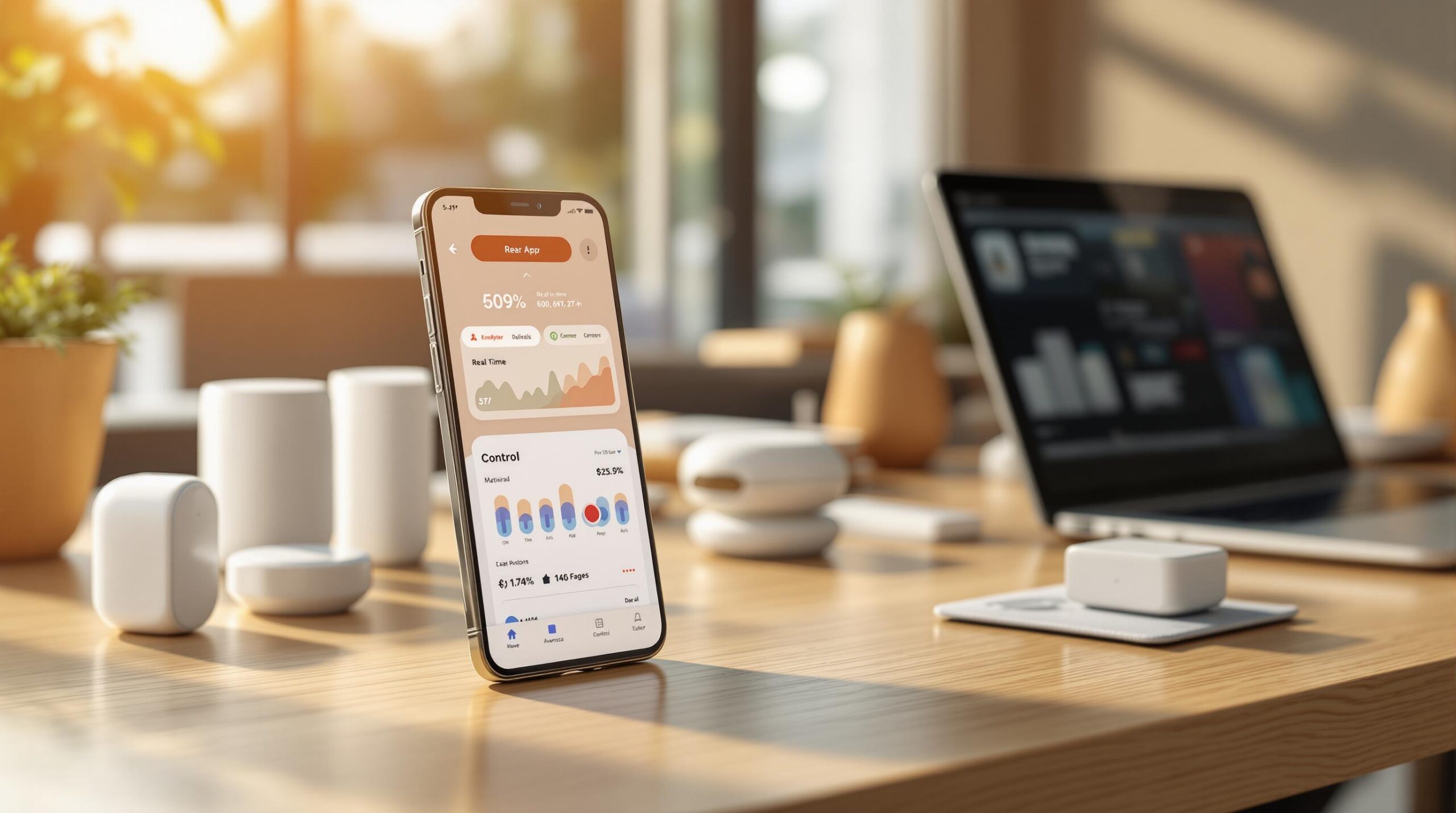
Custom mobile apps for IoT devices are essential when off-the-shelf solutions can’t meet specific needs. Here’s when they make sense:
- Advanced Device Control: For industrial equipment or complex smart home setups requiring precise, real-time control.
- Data Analysis: To process and display complex, real-time data from connected devices.
- System Integration: For seamless interaction with legacy systems, APIs, and diverse communication protocols.
- Security & Compliance: To meet industry-specific regulations and handle sensitive data securely.
Quick Overview
| Requirement | When Custom Apps Are Needed |
|---|---|
| Device Control | Complex automation, multiple protocols, industrial use |
| Data Analysis | Real-time monitoring, multi-sensor integration |
| System Integration | API connections, legacy system compatibility |
| Security & Compliance | Industry regulations, custom encryption, sensitive data |
Custom apps provide better control, scalability, and security, making them ideal for businesses with specialized IoT needs.
When Custom Mobile Apps Make Sense for IoT
Advanced Device Control Requirements
Custom mobile apps are crucial when IoT devices need specialized control systems. This is especially relevant for industrial equipment and advanced smart home setups where off-the-shelf apps can’t meet the demands. These scenarios often require precise, real-time control.
For industrial IoT devices, specific communication protocols like Bluetooth Low Energy (BLE) and Zero-Configuration Networking are commonly used to establish direct connections and identify devices on local WiFi networks. To ensure smooth operation and reliability, custom app development is often the best solution.
Custom apps also shine in handling intricate data outputs, going beyond just device control.
Data Analysis and Display Needs
Custom apps are highly effective at processing and displaying complex IoT data. With the number of connected devices expected to surpass 29 billion by 2030, organizations increasingly need tailored solutions to manage and visualize real-time data.
Take the UBreez IoT app as an example. It tracks indoor air quality by analyzing real-time data from sensors measuring temperature, humidity, pressure, CO₂, and VOC levels. The app sends instant notifications if any readings go beyond acceptable thresholds. This kind of monitoring can have a massive business impact – improving indoor air quality alone could save businesses anywhere from $25 to $150 billion annually.
System Integration Requirements
When IoT devices need to work seamlessly with existing business systems, custom mobile apps become indispensable. They act as a bridge between different protocols and consolidate data from various sources. These apps are particularly useful for:
- Over-the-Air Updates: Enhancing device performance remotely.
- Protocol Management: Managing communication across diverse device standards.
- API Integration: Enabling smooth interactions between devices and cloud platforms.
This level of integration also lays the groundwork for creating tailored security measures.
Data Security and Regulatory Needs
Custom apps play a key role in securing IoT environments. With IDC predicting that 40% of IoT data will be processed at the Edge by 2022, the need for strong security measures is more critical than ever. Custom mobile apps allow organizations to implement security solutions that align with specific industry regulations and internal policies, making them essential for sectors that deal with sensitive data.
| Requirement Type | When Custom Apps Are Needed |
|---|---|
| Device Control | Multiple protocols, industrial equipment, complex automation |
| Data Analysis | Real-time monitoring, specialized visualizations, multi-sensor integration |
| System Integration | Legacy system compatibility, multiple API connections, custom protocols |
| Security & Compliance | Industry-specific regulations, sensitive data handling, custom encryption needs |
Building a custom IoT solution for industrial air ventilation …
sbb-itb-7af2948
Advantages of Custom IoT Mobile Apps
Custom mobile apps designed for IoT devices bring clear benefits in terms of user experience, maintenance, and adaptability to specific needs.
Improved User Interface Design
Custom IoT apps enhance user experiences by offering interfaces tailored to specific devices and functions. These designs make devices easier to use and encourage adoption. For example, smart home apps often feature real-time data presented through interactive dashboards. Tools like color coding and graphs simplify complex information, making it more accessible. Plus, ongoing updates ensure these interfaces stay functional and relevant as technology evolves.
Long-Term Maintenance and Updates
A major strength of custom IoT apps is the control they provide over updates and maintenance. This means you can quickly address security issues, add new features, and implement changes based on user feedback. Such flexibility is crucial in the fast-changing IoT world, where staying up-to-date is essential for performance and security.
Custom vs. Off-the-Shelf Apps
When comparing custom solutions to off-the-shelf options, the advantages of personalized apps become even more evident:
| Feature | Custom Apps | Off-the-Shelf Apps |
|---|---|---|
| Customization | Full control over features and design | Limited to pre-built options |
| Code Ownership | Full ownership and control | No access to source code |
| Scalability | No limits on growth | Restricted by platform limits |
| Innovation | Freedom to develop new features | Bound by existing frameworks |
| Cost Structure | Higher upfront cost, lower long-term expenses | Subscription-based pricing |
| Market Advantage | Unique to your business | Accessible to competitors |
Custom apps also shine in automation, learning user preferences over time to streamline tasks and adjust connected devices automatically. This is especially useful in industries with specialized needs, where generic solutions often fall short.
Planning Your IoT Mobile App
To make the most of custom IoT apps, detailed planning is essential. Developing an IoT app requires careful attention to technical details to ensure strong performance and security.
Hardware Limits and Requirements
Your app’s performance and features are closely tied to the hardware it interacts with. Evaluate the processing power, memory, and communication protocols of your IoT hardware. For battery-powered devices, focus on optimizing data transmission to conserve battery life. Here’s how specific hardware components can impact development:
| Hardware Component | Effect on App Development |
|---|---|
| Processing Power | Determines app complexity and supports real-time tasks |
| Memory Capacity | Influences data storage and caching capabilities |
| Battery Life | Affects sync frequency and background operations |
| Connectivity | Shapes communication protocols and offline features |
| Sensors | Defines the range of data that can be collected |
Native vs. Cross-Platform Options
Deciding between native and cross-platform development is a key step. Native apps, developed with Swift (iOS) or Kotlin (Android), offer better performance and hardware integration. On the other hand, cross-platform frameworks like React Native can speed up development when targeting multiple device types.
Here’s how each approach stacks up:
| Development Approach | Ideal For |
|---|---|
| Native Apps | High-security needs, complex hardware interactions |
| Cross-Platform | Faster development, lower costs, simpler device communication |
| Hybrid Solutions | A middle ground between performance and speed of development |
Once you’ve chosen your development path, focus on securing the app.
Security and Compliance Steps
Strong security measures are non-negotiable for IoT apps. Here are the key steps:
1. Data Encryption
Use end-to-end encryption for all data transfers between IoT devices and apps. Stick to industry-standard protocols and update encryption methods frequently to stay secure.
2. Authentication Systems
Set up multi-factor authentication and secure user session management. This is essential for IoT devices in sensitive fields like healthcare or finance, where privacy is critical.
3. Regular Security Audits
Test security rigorously throughout the development process. Include penetration testing, vulnerability assessments, and code reviews to identify and fix potential risks.
Conclusion: Making the Custom App Decision
Creating a custom IoT mobile app starts with carefully assessing your specific needs and available resources. It becomes the right choice when your IoT devices demand precise control, advanced data analysis, or tailored security measures.
Custom development makes sense when you need to manage different device types, process complex analytics, meet high security requirements, or integrate seamlessly with existing systems.
These factors lay the groundwork for a successful project. Custom apps offer greater control over security measures, enabling strong encryption and authentication to safeguard sensitive information. They also support real-time data analysis, helping improve decision-making and boost operational performance.
To ensure success, focus on clear requirement definitions, select a scalable IoT platform, prioritize strong encryption and authentication, and plan for regular updates to maintain reliability over time.
While the upfront costs may seem high, custom development helps optimize resources and reduce long-term expenses. Investing in a custom IoT app can position your business for sustained growth and efficiency.

